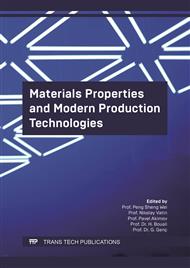[1]
Graybeal B.A., Material Property Characterization of Ultra-High Performance Concrete, FHWA-HRT-06-103, Federal Highway Administration, McLean, VA. (2006).
Google Scholar
[2]
Graybeal B., Ultra-High Performance Concrete, TechNote, FHWA-HRT11-038, Federal Highway Administration, McLean, VA (2011).
Google Scholar
[3]
Graybeal B., Construction of Field-Cast Ultra-High Performance Concrete Connections, TechNote, Federal Highway Administration, McLean, VA, FHWA-HRT-12-038 (2012).
Google Scholar
[4]
Graybeal, B. and Baby, F., Development of a Direct Tension Test Method for UHPFRC, ACI Materials Journal, Vol. 110, No. 2 (2013).
Google Scholar
[5]
Graybeal B. and Yuan, Jiqiu Bond Behavior of Reinforcing Steel in Ultra-High Performance Concrete, FHWA-HRT-14-089, Federal Highway Administration, McLean, VA (2014).
Google Scholar
[6]
AASHTO Highway Subcommittee on Bridges and Structures, AASHTO LRFD Bridge Design Specifications, Washington, DC, AASHTO (2017).
DOI: 10.1201/9780429485473-12
Google Scholar
[7]
CSA S6-14, Canadian Highway Bridge Design Code, Canadian Standards Association (CSA), Mississauga, ON, Canada (2014).
Google Scholar
[8]
NF P18-710, National Addition to the Eurocode 2 – Design of Concrete Structures: Specific Rules for Ultra-High Performance Fibre-Reinforced Concrete (UHPFRC), AFNOR, Paris, (2016).
Google Scholar
[9]
Schachinger I., Hilbig H., Stengel T. Effect of Curing Temperature at an Early Age on the Ling-Term Strenght Development of UHPC, Schachinger I, et al., Second International Symposium on Ultra-High Performance Concrete, Kassel, Pp. 205-212 (2008).
Google Scholar
[10]
S. Peiliang et al. The effect of curing regimes on the mechanical properties, nano-mechanical properties and microstructure of ultra-high performance concrete//Cement and Concrete Research, Vol. 118, Pp. 1-13 (2019).
DOI: 10.1016/j.cemconres.2019.01.004
Google Scholar
[11]
N. Parameshwar, Effect of different curing regimes and durations on early strength/ Parameshwar N. Hiremath, Subhash C. Yaragal // Construction and Building Materials. Vol. 154, Pp. 72-87 (2017).
DOI: 10.1016/j.conbuildmat.2017.07.181
Google Scholar
[12]
T.M. Ahlborn, Durability and strength characterization of ultra-high performance concrete under variable curing regimes/ T.M. Ahlborn, et al. // Transportation Research Record: Journal of the Transportation Research Board – 2011. – 2251(1), - Pp. 68-75.
DOI: 10.3141/2251-07
Google Scholar
[13]
Ye Li, En-Hua Yang, Kang Hai Tan, Effects of heating followed by water quenching on strength and microstructure of ultra-high performance concrete / Ye Li, et al. // Construction and Building Materials, 207, Pp. 403-411(2019).
DOI: 10.1016/j.conbuildmat.2019.02.123
Google Scholar
[14]
Wenzhong Z. Compressive stress–strain relationship of steel fiber-reinforced reactive powder. Construction and Building Materials, Elsevier, 35 (2012) 931-940.
DOI: 10.1016/j.conbuildmat.2012.05.031
Google Scholar
[15]
V. Dorf, Pozzolanic effect at high temperatures of high strength cement-sand matrix of steel-fiber concrete/ V. Dorf, et al. // Vestnik grazhdanskikh inzhenerov – Bulletin of Civil Engineers, no. 2 (61), p.178–183 (2017).
DOI: 10.23968/1999-5571-2017-14-2-178-183
Google Scholar
[16]
Soloviev V., Efishov L., Matyushin E., Structure formation of UHPC with metal fiber exposed to high temperature curing / Soloviev V. et al. // IOP Conference Series Materials Science and Engineering, 2020, 869 032015 (.
DOI: 10.1088/1757-899x/869/3/032015
Google Scholar
[17]
Soloviev V., Influence of steam curing on properties of fiber-reinforced concrete during hardening / Soloviev V., et al. // MATEC Web of Conferences, Vol. 251 010331 (.
DOI: 10.1051/matecconf/201825101031
Google Scholar
[18]
Begunov O., Alexandrova O., Solovyov V., Studying of influence of fiber reinforcing at fine-grained concrete applying in transport construction / Begunov et al./ IOP Conference Series Materials Science and Engineering, 90 012016 (doi :10.1088/1755-1315/90/1/012016) (2017).
DOI: 10.1088/1755-1315/90/1/012016
Google Scholar
[19]
Caijun Shi, A review on ultra-high performance concrete: Part I. Raw materials and mixture design/ Caijun Shi et al. Construction and Building Materials. Vol. 101, pp.741-751( 2015).
DOI: 10.1016/j.conbuildmat.2015.10.088
Google Scholar
[20]
Cheyrezy M., Microstructural analysis of RPC (Reactive Powder Concrete) / Cheyrezy M. // Cement and Concrete Research. - Pergamon, Vol. 25(7), pp.1491-1500 (1995).
DOI: 10.1016/0008-8846(95)00143-z
Google Scholar
[21]
Shamsad A., Mechanical properties of steel fiber-reinforced UHPC mixtures exposed to elevated temperature: Effects of exposure duration and fiber content / Shamsad A. et al // Composites Part B: Engineering. – Elsevir. Vol. 168. Pp. 291-301(2019).
DOI: 10.1016/j.compositesb.2018.12.083
Google Scholar
[22]
Kodur V.K.R Fire Resistance Design Guidelines for High Strength Concrete Columns, NRCC-46116, National Research Council Canada (IRC), Baltimore (2003).
Google Scholar


